How to organise a kitchen – 18 simple steps recommended by experts
Learn how to organise a kitchen with our practical, expert guide to creating a streamlined cooking and dining space


When looking to organise a kitchen it pays to be methodical – go through your kitchen cupboards, drawers, countertops, and surfaces to declutter and reevaluate your space before you start to try to restore order.
Having a kitchen space that is in order can bring so much satisfaction. And it has other benefits too – an organised kitchen makes it easier to cook and entertain, whilst also making cleaning your kitchen easier too, for a happier and healthier environment overall.
To create the ultimate guide for organising a kitchen like a pro, we explore expert kitchen storage ideas and simple steps to follow to get your space in order so that with a bit of effort, you can make sure the big declutter is a one-time-only event that leaves your kitchen functional forever more.
How to organise a kitchen: 18 expert tips
As the heart of any home, it is all too easy for kitchens to be clutter-magnets. From bulky on-trend kitchen appliances to miscellaneous items in kitchen drawers, if you don't keep on top of things the task of organising a kitchen can soon become overwhelming.
It's best to take a methodical approach when organising a kitchen to restore order and ensure it stays that way with small daily habits to keep the space clean and tidy.
1. Consider how you use the space
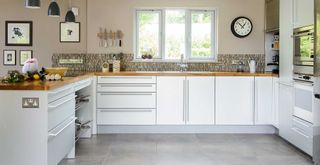
Before you start to organise your kitchen, consider how you use the space and if you could utilise it better. Our interior expert Jennifer Morgan says you first have to ask the following: "Is your kitchen set up for the way you live today? Are there congestion zones that cause a headache in the mornings, when multiple people are all trying to make tea/toast/feed the cat at the same time?"
"Do you have serveware rather than everyday crockery in most-used cupboards? Has your island become a WFH office complete with a tangled mess of chargers? Before you start sorting observe how your kitchen is used and what are the problem areas."
Sign up for the woman&home newsletter
Sign up to our free daily email for the latest royal and entertainment news, interesting opinion, expert advice on styling and beauty trends, and no-nonsense guides to the health and wellness questions you want answered.
Once you imagine how the space could be used for better efficiency it's easier to make a plan to start the decluttering process.

Jennifer Morgan is an award-winning editor, writer and stylist, with over 25 years of experience writing, styling and editing home interest magazines. A few years ago Jennifer realised her dream of publishing her own magazine – Simply Scandi, a magazine for Scandi lovers, featuring interiors and lifestyle content.
2. Empty all cupboards and drawers
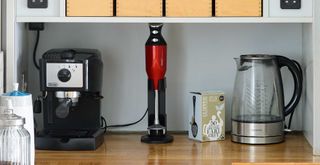
What’s lurking in the back of your kitchen cupboards? It's time to expose each and ask yourself if it's entirely needed. It's best to empty every cupboard and drawer to access exactly what lives in each.
It is best to do this one at a time, otherwise, you run the risk of feeling completely overwhelmed – and losing motivation to declutter.
"Are your cupboards currently home to rarely-if-never used small appliances and gadgets," says Jennifer. "Bring each out from their hiding space, and be brutal – will you use this again/did you EVER use it? If the answer is no, then liberate that cupboard for something else."
3. Designate dedicated zones
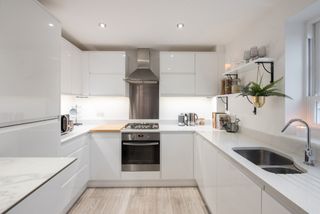
Next, it can be helpful to divide your kitchen into 'zones'. This will help you to compartmentalise the process of organising and to help you focus on what you need and where.
The first principle to consider when dividing your kitchen into zones is the 'work triangle'. Katherine Blackler, a certified professional organiser, explains, "Create zones so you can easily find what you need when you need it and group like items together."
"Most kitchens have the traditional ‘work triangle’ with minimal distance between the three key areas of the cooktop, the sink, and the refrigerator, helping the user flow between these as effortlessly as possible."
A similar ‘ease of use’ principle applies when you are planning out the surrounding storage and organisation of your kitchen.
You can divide the kitchen into zones however you'd like, but it might also help to look at it this way:
- Zone 1: Utility areas - sink, organise under the kitchen sink, any space around the sink used as a cleaning cabinet
- Zone 2: Countertops - everything that is already on your counters
- Zone 3: Upper storage - perhaps the biggest zone of all, this zone includes all of the cupboards and everything inside – cutlery, glassware, crockery the lot
- Zone 4: Lower storage - this might be where you keep pots, pans and any miscellaneous kitchen gear, for example, appliances, your best cookbooks, useful kitchen gadgets, special glasses or serve-wear
- Zone 5: Pantry - if you don't have an actual pantry or a pantry space, this is where you keep your dried kitchen goods, such as spices, baking ingredients, cereals and tinned goods
- Zone 6: Fridge - this might not strictly be a zone, but it can be helpful to consider this space when organizing your kitchen. Lots of the below tips can be applied when organising your fridge too
"Consider the lowest shelves of any wall-mounted cupboards, your countertop and the upper shelves of under-counter cupboards as “prime property” essentially, all the areas you don’t have to crouch down or overstretch to reach," Katherine advises. "Use the areas farthest from your ‘work triangle’ to store any produce and items that are either used occasionally or are food items that are deployed and not returned to storage."

Dubbed 'The Personal Trainer for your Home, Katherine is a high-energy individual with an inherent passion for bringing order from chaos and making everyday life that little bit easier. Based in London and owner of SortMySpace Ltd, Katherine Blackler is the first CPO® Certified Professional Organiser in the UK, and the past President of APDO Association of Professional Declutterers and Organisers in the UK.
4. Access items you don't use
As a general rule, if you haven’t used something for a year, get rid of it – this will help you to organise a kitchen. There may be one or two exceptions, but there’s usually no point in keeping an appliance or utensil you rarely use.
"Be honest about whether you use them or not and make sure you give everything a home" advises APDO’s Jacqueline McLeod, founder of Bancrofts Organisation Services.
"Consider how the kitchen works best for you and make sure items you use regularly are easily accessible" advises Jacqueline. "For example, keep essential cooking utensils in a holder so you don’t have to rummage around whenever you cook. Conversely, if you don’t use certain appliances often, put them away in a cupboard – have a space dedicated to appliances."
If you really can’t bring yourself to get rid of something and you’re convinced you will use it again, consider making a donation countdown box – set a date six months or one year in the future, put the box away, and if you haven’t needed or missed those items by the time that date arrives, take them to a charity store.
5. Start to declutter by category
When you do an initial declutter, you’ll need to take everything out so you can see what you have and clean your cupboards and drawers before putting anything back in. To make this stage less overwhelming, focus on one category of items at a time (eg. dishware, baking equipment, cutlery) before moving on to the next.
For every item, ask yourself if you use it, if it's a kitchen essential, and if you’d buy it again today – this will help you decide which items to keep and which to lose, and in turn, create a more organised kitchen.
6. Dispose of surplus food

To organise a kitchen effectively, you can't have too many excess items. If your food cupboards are bursting at the seams, take time to go through everything in them and get rid of what you don’t use. This is one easy way to get organised quickly – as it'll likely reduce the number of items in your kitchen pretty quickly.
You'd be surprised how long items can live in cupboards before you clear them out, but when you consider how much valuable space they take up it's worth doing a stock-take regularly to maintain an organised pantry of useful ingredients.
"Go through food cupboards and check the use-by dates," Jennifer advises. "If you decant dried ingredients into jars, write the date opened on a piece of masking tape and pop on the base. Leave no packet unchecked, even your spices and freezer contents. If you can’t remember the last time you used it in a dish, think ‘Will I even use it again?’ If the answer’s no, then bin."
Throw away anything that is out of date or donate in-date, unopened food that you won’t use to a food bank.
7. Tackle the junk drawer

To truly organise a kitchen you need to tackle the misused drawers because organised kitchen drawers are a must. Every home has a junk drawer and this is a key zone to tackle because it's all too easy to let it get out of control.
Every kitchen has one, whether it’s the utensils drawer, the ‘useful’ stuff drawer, or the saucepan drawer. Take everything out and only put back what you need or use. Use drawer organisers to help keep it tidy in the future, while see if stacking pans with felt liners helps max out the storage in pan drawers."
Most things kept in the junk drawer, for example, could be rehomed and kept in a more suitable place, candles, tools, or stationery. If you do need some of these items in the kitchen, consider using a kitchen drawer organiser to separate items by category so it doesn’t become a free-for-all.
8. Find a place for frequently used items
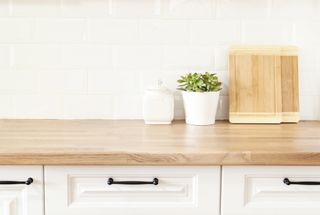
Whether you're looking at your cleaning zone, your pantry zone, or your cupboards, be sure to put the items that you use most often in the easiest spots to reach.
For example, keep your mugs in the cupboards nearest your kettle and if you're a regular smoothie maker, don't stuff your best air fryer or your best blender at the back of one of your cupboards far away from the fridge.
Other handy places for frequently used items include:
- Keep oils and seasoning near the cooker and hob, so you can apply a dash of it to your food and return to its home in one maneuver
- Have tea and coffee supplies stored near the kettle and cups
- Put table mats or napkins in a drawer near the dining table
- It also makes sense to ensure your food prep station is close to your bin, to ensure you're not walking around with a chopping board and knife to get to the bin
- Fresh food that doesn't need to be refrigerated should always be as far away from the cooker/hob as possible, to avoid it decaying too quickly
9. Use baskets to keep cupboards tidy
Investing in the right organisation tools such as baskets, jars, or bins could help you to make better use of space to organise a kitchen. There are many options on the market for both drawers and cupboards, but we'd suggest using baskets for long deep cupboards that can sometimes feel like a never-ending pit of darkness.
Use baskets to put in either foodstuffs or kitchen appliances, to hide everything away neatly inside cupboards. By having your items in a basket, you can easily pull it out to grab what it is you are searching for, instead of rooting around for it with your entire arm in the cupboard.
This can also help you organise your items perhaps put all of your baking equipment in one basket and your tea towels in another, for example.
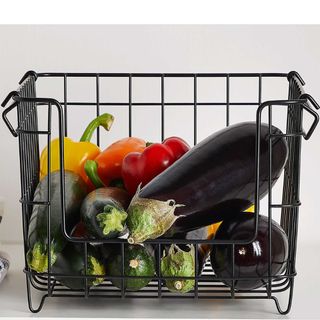
£7.50 | The beauty of this storage basket is the ability to stack multiple baskets to fill cupboards and utilise space with efficiency. The basket is designed with an open end, affording easy access to the items being stored inside.
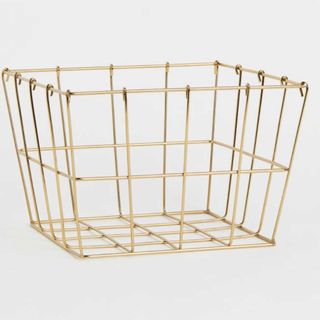
£9.99 | Store all manner of store cupboard ingredients or even linens in this chic gold-coloured wire storage basket from H&M. This large metal wire basket measures 16.3cm in height and 24.3cm at the widest part.
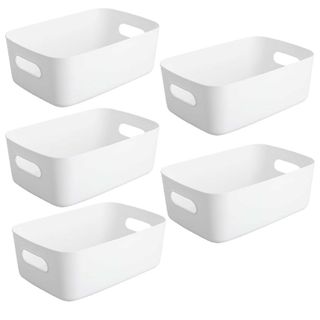
£13.99 | Fitted with handles, to ensure they can be easily moved this pack of 5 storage baskets is ideal for cupboards filled with cleaning products and loose goods.
10. Decant into display containers
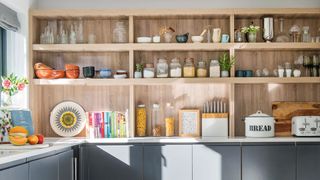
Keeping the food items you use the most, such as pasta, potatoes, or cereals, in clear containers is an easy way to source an item simply when you need it. It can also be a real space-saver, allowing you to get rid of bulky cardboard boxes. Containers such as these on open shelves aren't only a practical kitchen organisation solution, but they're a top kitchen trend in 2024, too.
"Putting items for your pantry/food cupboards in airtight containers helps maintain freshness but also allows you to see what you are running out of" explains Jacqueline. "Label them and organise them according to food type and then expiration date."
Once you've sorted the items you use most into clear containers, make sure to follow our earlier tip of placing them in the most easily reachable space, so you don't waste time and effort searching for them.

£12 | Whether on a countertop or in an organised pantry this stylish jar from John Lewis is a sure way to bring fashionable order to your food storage. Seen here in in on-trend tone of Damson this jar is available in 6 other pleasing colours to suit all kitchen colour schemes.

£8 | These simple yet stylish glass jars by Shelf Life feature personalised labels to ensure tailored storage to suit an individual household's needs.
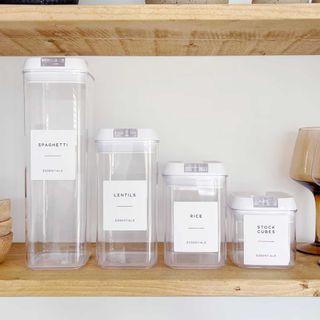
£7 | These square clear plastic storage jars feature airtight flip-lock lids to guarantee freshness. The minimalist storage containers by The Shelf Life Shop also feature personalised labels to restore order to your food supplies.
11. Rethink your kitchen cabinet organisation
Lazy susans and stacked kitchen cupboard inserts are a fantastic way to organise kitchen cabinets and cupboards, as they allow you to see everything you have easily, without rooting around.
Lazy susans are a great place to put taller kitchen food items such as condiments - think soy sauce, salt and pepper grinders - because they have a thin base that allows you to make the most of your cupboard space.
Kitchen inserts are also great for spices if you don't want a spice rack out on your countertop (or don't have a spices drawer or cabinet). They allow you to display twice the amount of spices in the same cupboard, so are a fantastic space-saver.
Expert declutter's top tip: "Organise your spice rack alphabetically or based on the expiration date" advises Jacqueline. "If you don’t have room for them in your cupboards hang them in a spice rack on the wall."
12. Streamline what you have out on your counters

When it comes to organising kitchen countertops Katherine explains, "To give you the best illusion of calm and space (and make cleaning easier), countertops need to only home the items you use on a very regular basis. For each household, this varies."
"If you use certain kitchen gadgets frequently, whether that’s a toaster, juicer, bread maker, air fryer, etc (or you have issues lifting heavier objects) then you might justify them being out permanently on display." For example, leaving your coffee machine out might make things much easier, and save space in a cupboard too.
"But," Katherine says, "if countertop space is limited, there are a few hacks for making this tip work for you. Perhaps consider investing in boiling water taps to remove the need for a kettle. Or, if you're short on space, consider using the grill for toast. If you keep a fruit bowl out, ensure it’s only filled with fruit and not crammed up with medicines, keys, and a random assortment of bits. That’s what the junk drawer is for."
13. Utilise wall space for extra storage
If you've gone through your kitchen decluttering, have all your items in your kitchen cupboards well organised, and your counters clean and streamlined but still need some extra space for essential items, making use of your walls for storage is a fantastic option. This is especially important for small kitchen storage ideas.
You could install a hanging rack for pots and pans, wall hooks for things like tea towels, a magnetic knife holder, or any number of things. Check out our clever pots and pan storage ideas for more creative solutions on how to make the most of your wall space. The more creative the better.

£ 148 | IKEA is a great place to head if you're looking for affordable kitchen storage units. Take for instance this wall-mounted design that offers shelves and hanging racks to provide plentiful storage for utensils, pots, pans and more.
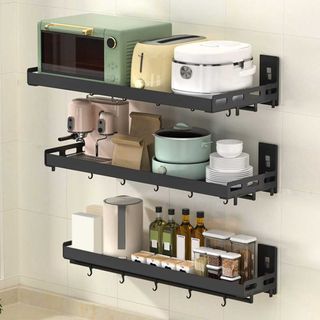
£44.09 | This impressive storage solution is ideal for those looking to free up valuable kitchen counter space. In addition to the top shelf designed to store smaller kitchen appliances, the rack features a hanging organiser with a rod and 5 hooks - ideal for kitchen linens or utensils.
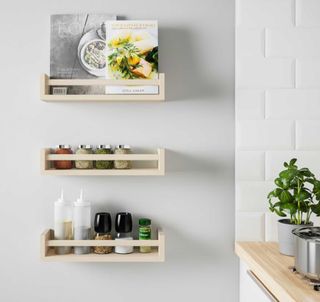
£3 | Intended as a spice rack but not limited to just that one function, as clearly demonstrated the racks are also ideal for displaying cooking books and condiments.
14. Tidy away tech
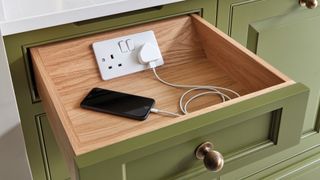
Organising a kitchen well isn't just about getting rid of things - it can also mean making clever additions to your kitchen too. Once the junk drawer is clear consider implementing a multipurpose drawer instead, providing concealed, easy-access storage.
"Bespoke charging drawers are becoming increasingly popular in multifunctional kitchens" explains Tom Howley, founder of Tom Howley Kitchens. This helps to keep all your charging cables organized in one place, while also hiding the offending items from view when neatly tucked into a drawer. And it's not just for cables, this can take over as the drawer to store all manner of useful items that normally clutter your kitchen countertops, from keys to shopping list pads.
"Choose from multiple plug points, USB sockets and more. It’s also best to create a drawer close to where you usually put down your phone and keys after arriving home," notes Howley.
15. Follow the 'one in, one out' rule
To fully organise a kitchen, you need to be able to maintain the space easily too. Along with having a place for everything, it can be a good idea to follow the professional decluttering method of one-in, one-out, especially if clutter is overwhelming your otherwise organised kitchen. This means that when you buy something new (an appliance rather than food), you must get rid of something else that you don’t use.
It requires a lot of self-discipline, but once it’s a habit, it will lead you to shop more mindfully and think carefully about what you need in your home.
16. Adopt a daily kitchen reset
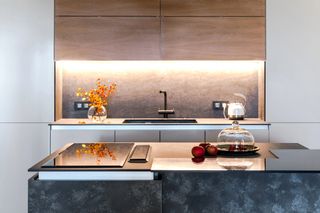
According to experts from The Declutter Hub, incorporating a regular reset into your day is the key to staying on top of clutter. Lesley says, “Basically, there will be one or two times a day where you ensure your kitchen is completely tidy and reset for the day.”
So take a little bit of time after washing up - maybe when you clean your stovetop after cooking – to put things away and find a home for any clutter that’s starting to build up on the countertop.
17. Dedicate a regular organisation day
To be able to organize a kitchen as little as possible, a regular day of organising can help. As with every room when it comes to decluttering your home, your kitchen will need fairly regular maintenance – but hopefully, after implementing all of the above tips, this should be quite speedy.
Food cupboards and drawers can get out of control quickly, so you may also need to set aside a weekend morning each month where you throw out expired food and anything else you know you won’t use, either by donating or binning it.
Turn this activity into a routine and pair it with your favourite music, audiobook or podcast, so it doesn’t seem like such a chore.
18. Shop mindfully to avoid excess
This applies both to food and other kitchen items. When you shop, think about what you use and what you need, as well as the space you have, to help your kitchen stay organised.
For example, Lesley from The Declutter Hub suggests, “If you don’t have space, don’t bulk buy. If your shelves are not high enough for a 750g of cereal, buy a 500g bag instead.” These are examples, but the principle applies throughout only buy what can reasonably fit in your space.
If you think you can commit to keeping it updated, create an inventory on your phone of all the basic store cupboard ingredients you have at home including things like herbs and spices. Or, if you prefer a good old pen and paper, this is fine too. This can then be a helpful reference when you’re food shopping and will stop you from buying what you don’t need, to create a more organized and streamlined space.
What is the best way to organise a kitchen?
The best way to organise a kitchen is to plan. "When it comes to kitchen organisation, first, you should zone the space" explains Tom. "Kitchen zones can include cooking, prep, entertaining, dining, consumables, and cleaning. Having designated areas will allow you to store and organize items efficiently. Group similar items together. For example, tableware and glasses should be kept near your dining area. Similarly, essential food items, utensils, and pans should be placed close to your cooker for easy access."
To gather motivation before the big declutter, and to help with the ongoing effort of maintaining an organized kitchen, it’s worth getting some visual inspiration. Having points of reference will make the organization process quicker. And this can be found in all sorts of places – from TV to social media, or even other books.
Follow a few organisation influencers on Instagram, watch Get Organised with The Home Edit on Netflix, or join a Facebook group dedicated to decluttering, where members share advice about decluttering and share their best organisation ideas. These will also help you to work out your favourite tips when the time comes to organising a kitchen.
"Long-term organising involves a change in mindset," explains Lesley Spellman, at The Declutter Hub: "When shopping, getting a grip on your aspirational habits, shopping intentionally, and constantly reviewing your lifestyle to make sure your kitchen and the things in it reflect your current self. For example, if you are a simple cook who relies heavily on convenience, don’t fall into the trap of buying all the latest gizmos and gadgets."

Tamara is a highly experienced homes and interiors journalist, with a career spanning 22 years. Now the Lifestyle Editor of womanandhome.com, she previously spent 17 years working with the style teams at Country Homes & Interiors and Ideal Home, and it’s with these award-winning interiors teams that she gained a wealth of knowledge and honed her skills and passion for styling and writing about every aspect of lifestyle and interiors.
A true homes and interiors expert, Tamara has served as an ambassador for leading interior brands on multiple occasions, including appearing on Matalan’s The Show and presenting at top interior trend forecasting events such as the Autumn Fair and Spring Fair.